Fundamentalist Christians and its Wrong Approach to Spiritual Teachings (28):
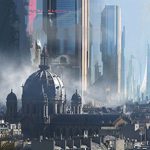
The God of the Machine will come Down to Save Us:
.

.
.
God Help us; He May not; so, save Your Self [Collectively] [Posted initially on 18th November 2021]: Continuing from the previous post, we discussed the Christian’s detrimental use of utilitarian mysticism and hero worship. This can be recognised in many ways, from the slow birth of social movements to the takeover of ‘words’ to impose new meanings. Taking the word ‘leftist’ together with scapegoating and blame leaves little for the flexibility of truth. To be left has lost all its meaning because it’s been redefined or is a product of linguistic takeover. Essentially by right-wing-crypto-fascist groups, this has been in long development way before Trump. The fascism of the Christian right embodies Christian values that have been upheld.
In the beginning, it was about the acquisition of material wealth and power sacralising the worst aspect of imperialism and capitalism alongside a [subtle but] growing white-supremacy movement. The notion that America exclusively is anointed to bring about the Kingdom of God and that the white race is lifted above all other races. Here it parallels the Christian Church that the Nazis created in Germany during the war era on the worship and sacred quality of state power. In the 80s, the Christian right was a marginal group, but even back then, one could determine or estimate a possible future where their ascendancy could have weight on policymakers. Today’s many conservative Christian gatherings fill stadiums.
Even amongst this populace group, there are dispossessed people, poverty-stricken, with high statistical domestic abuse, alcoholism and so on, who would garner themselves into crisis cults. They believed Jesus would take care of them and bless them with wealth. Even at their lowest, mysticism as a form of action is enough for contentment. Another linguistic takeover of the word ‘socialism’ means communism to them. Even though what holds them together in their lowest form as a lifeline is from liberal socialist programs. Incidentally, they still give loyalty [their vote] to a political paragon saviour as a replacement for their Jesus. In a blind hope … for a Jesus that will never come, to unquestioning loyalty for a political saviour on the whims of his gas-lighting. All a while abandoning their needs, especially in poverty.
Having the loyalty of this populace, Christian-right institutions like Liberty University, Patrick Lawson School, and other Christian schools would integrate some of those graduates into the Trump administration. They had the same magical thinking as them, but it was only conducive to a type of capitalism that took advantage of their voters. The policies made throughout history and economics function in the same way as mysticism, the rise of intense outcomes followed by depression, and match the cycles of fashion.
It’s impressive how adjacent the neoliberalism ideology is with the Calvinism branch of Protestantism insofar as a need to strive for success in an unhealthy manner [to climb the corporate ladder as a leader]. To prove they were the elect destined to go to heaven. Neoliberalism [a notion that societies could advance themselves by kneeling before the dictates of the marketplace] is an ideology pedalled by corporations as a reaction to rising movements. Think tanks created blueprints for corporations to slow down those movements and take control of institutions, which justified the pillage by the ruling elites. People who didn’t play frailty to neoliberal ideology were silenced, as they called neoliberalism a con. Both social and political establishments had to pay frailty to them to survive. A figure like Clinton would come and essentially transform the Democratic Party into a Republican Party. They pushed it so far to the right that it became wild, and low and behold, Biden was part of that administration. This was essentially the death of the liberal class and the rise of something else.
Their inability to process [Biblical] mythology properly, while also having a hard stance on individualism, builds walls because there, the chosen elect will always steer towards fascism. Together with a populace that has a suicidal fervour, blind submission, and loyalty to proto-fascist authority, it gives no hope for a better future. The literal [Biblical literalism] having always produced idolatry makes it hard for them to accept concepts like the ‘Christ of Faith’, which adopts a malleable model. It sometimes makes for a more fascinating story or parable, although fundamentalists have rejected this outright. They take comfort only in passages of Luke 2:41-42 as the only source because, according to them, this is all that God has determined that we need to know, as examined in the argument, which entails the lost years of Jesus. The unknown years of Jesus can be ripe with speculation; some have indicated He was in Tibet, Kashmir, India, and Egypt, learning the ways of enlightenment. Whatever the case, a process entails swapping creative reasoning with God. When you swap reason with God or value reason as the godhead, you put absolutism in the forefront, which can be impossible to argue against.
At the heart of Christian Religion, it doesn’t ask what absolute truth is because they believe they’ve found it. In Buddhism, the reply is always – ‘there is nothing absolute in the world’, but the process of thought and argument is central to our continued existence – if for no other reason than its role in making us conscious of the world. So, the absolute goes against your natural self. Although what is certain is our mortality and that it leads to death, even in this notion, death or, more precisely, health care can be hijacked by big pharma and profit.
The notion of death among hospitals and medicine, especially on the value towards the terminally ill by prolonging it. Drugs and technology may delay it, but the outcome is the same: death looms, but it’s the ability to think and the ability to illuminate disease that gives reason strength. This often has a cyclical nature. The false progenitors that act as saints for the God of the machine adopt this method to impose a [covid] vaccine as law to protect us. Although we know in practical terms, laws do not protect us, nor our systems. They protect us only through one’s individual ability to think through the situation by controlling ourselves.
A conspiracy among the so-called experts that uses our culture and ideology as a phenomenon, together with fake news media, provokes a sense of aggression and disbelief in the dictum “Scientist Say” – and we know it’s not the scientist. It’s the political relations department of the scientific community, their publicity apparatus. They’re telling what the scientist should say to the public. They should not be confused with real scientific progress in medicine, but that always starts at the micro level, often without a worldwide propagandised fake hysteria.
Here, it hints that reason is tying itself through progress; in this predicament, you limit thought by basing it on delusion. And so, it slips into a tool for self-interest and ideology. They have hacked the genuineness of ‘care’ and inverted [or corrupted] it. In the genuine form, pain is reduced so that one can think and have clarity of mind, as well as deal with their thoughts while dealing with their suffering. And remind them that death is not a disease but a part of life. At least in death, you’re liberated from truth, method, and utilitarianism’s delusions.
Metaphysical, Post-Perennial Mumbo Jumbo: What is truth anyway? Truth must also be seen in the realm of non-absolute [or in the ephemeral]; otherwise, it won’t evolve. Truth is Ayn Sof or the process of seeking Ayn Sof but never really reaching it. There are many aspects to view truth. One way can be seen through a post-Jungian analyst, James Hillman’s ‘The Dream and the Underworld’ He relates our dreaming life to the myths of the Underworld – the dark side of the soul, its images and shadows – and to the gods and figures of death. This leads to a re-visioning of dream interpretation concerning the psychology of “dying”. He concludes with a long section on specific dream images and themes as they appear in psychological praxis. He describes the value of not remembering dreams examined in the body when it processes information; something unconscious remains, and this has value, and if you can recall, it gives it objective reason.
Some have likened the process of seeking truth to a game with modalities. One way is similar to reassembling a shattered psyche following a Christ-consciousness awakening event, which represents the divine spark that needs to emerge. Reconstructing the psyche is like Kintsugi. This art form celebrates imperfections and is often connected to the recollection of dreams, which is symbolized in the myth of the underworld. Author Philip K. Dick discusses his spiritual awakening when he interacted with the wisdom goddess Sophia, who mentioned that she enjoys solving puzzles. The experience of not fully remembering dreams but catching glimpses of meaningful images is akin to working on puzzles, where the dreamer must reconstruct the visions or images together.
The Gnostic Gospel of Thomas – The Hymn of the Judas Thomas the Apostle in the Country of the Indians, also known as The Hymn of the Pearl – tells the story of a prince who is sent on a mission by his father and along the way forgets his true (secret) identity. The forgetting parallels humanity’s ignorance, and only upon the awakening that one finds ‘knowing’ [or perhaps remembering once again] and, therefore, one’s true mission. As seen in modern-day moving pictures, the gnostic parable follows the same perennial concept of ‘the one’ motif: forgetting, awakening, and saviour.
The Goddess and her puzzles equate to a game of remembering. The metaphysical or alchemical status of consciousness hinges on believing in God and vice versa. Ontology plays a part in so much as ‘reality’ comes first in the value of importance before consciousness, but still realizing there is a relationship between the two. This is a valid argument for the material, considering that outside perceptions are being given to us and that it cannot be all consciousness, the collective unconscious, or the collective dream. However, what pervades materialism or the sciences, more so towards Astro/atomic physics, is the idea that the world of matter is what matters, which is invalid. Black holes are not material objects; it’s an idea. The vacuousness of the material as a category, even at the heart of physics, is contentious. There is no sense of the material object that covers this sort of enquiry that physics is doing. Astrophysics attempts to define the universe through atomic ideas, which doesn’t work [as above; so below may not work in this case]. The same confusion arises when they mix satellite cosmos with plasma physics.
The evolution of Blackhole imagery ends with a copied similarity to Saturn imagery. And suppose you take the supposed image of Earth and blur out the edges. In that case, it’s nothing but a topographical keyhole image or a microscopic lens for a higher intelligence [a.k.a. God] on an infinitely large plain.
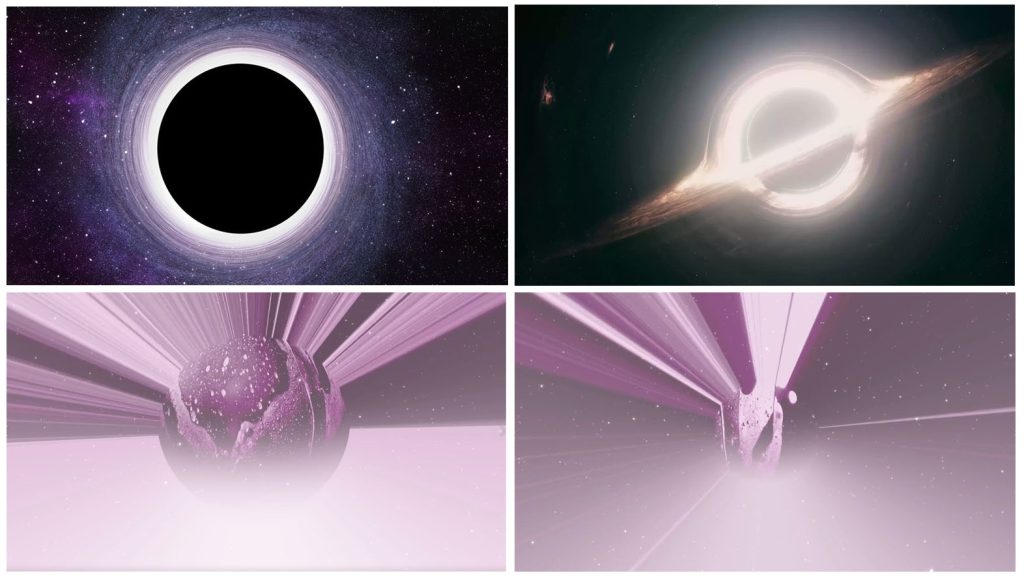
An unedited version of audio and video of the lunar landing outlines its disingenuous picture of Earth at a distance. As well as radio conversations between astronauts, Houston and also a third member, they outlined a script on what to say for playback later.

The Federal government would have you believe that this is an image of Earth from a distance looking out of a spacecraft through a window as it nears the moon – it is not – what they have done is placed the camera at the back of the [space] craft and ascended the lens on a circular window on the foreground – outside of which is completely filled with the Earth in low orbit – the circumference of the window would appear as the diameter of the Earth at a distance. The blackened walls of the craft appear as the blackness of space.
The concept of squaring the circle, as understood – is about drawing down the divine structure of the universe. Man’s attempt to recreate that in this lower plain is a two-dimensional project of man. At some point, they came up with the irrational number of Pi. And Pi allowed calculations to reach their nearest perfection after utilising this number that had no end extended that formula in trying to create a kingdom of God on earth. Our disconnection from the godhead made us aware of our spiritual loop, our shadows, and the underworld so that we could remember that source point again. This disconnect is perhaps instinctive as to acknowledge your surroundings as your map. Let’s say that the map is civilisation and society, but it is not perfect because it’s a system built to fail and restart. Like a mandala, it’s made only to be erased, and like in history, civilisation rises and falls because of its cyclical nature.
Pi is infinite, and the Fibonacci sequence is found in nature, particularly in flowers, where it follows a mathematical spiral. Fractals give a sense of infinity, leading to ideas like simulation theory. However, while the flower itself is complete, the notion of an infinite virtual component represents the cycle of death and rebirth. This infinite state allows for observation, contrasting with the idea of infinite satellization, which often involves myths. It is important to remember that mathematics is a paradigmatic example of a science connected to the nature of things if theoretical frameworks or beliefs are applied. This means that mathematics can potentially be incorrect if the initial assumptions are flawed.
This can be examined in cult followers of Lyndon LaRouche; his notions probably influenced the Saturn Cult. He purposed that at the centre of all reality, there is an invisible point that is a perfect sphere, and at the exterior of reality, there is an enormous sphere. Where one could hold the entire universe in one hand, a spherical object as large as the universe, scale and size are disregarded. Thus, any concept of squaring this Sphere in a four-dimensional extension is a false model or a false reality – because no matter how close you get to filling the interior space with Cubes [of innumerable sizes], there is always an infinitely large space to be filled. Therefore, the spherical reality is more accurate, and the reality inside the Cube is run by forces and agents emanating from Saturn.
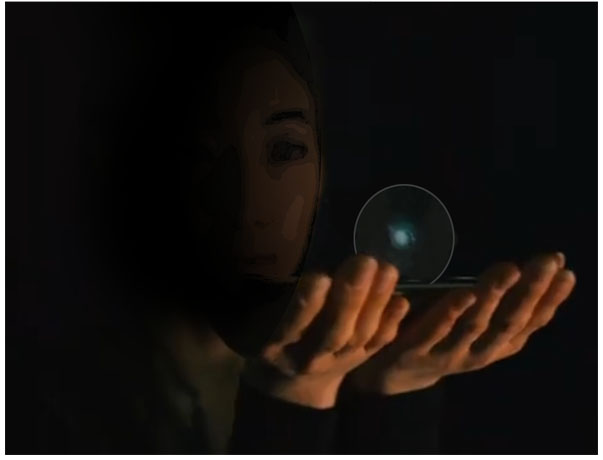
This is no different to the Cube within a Cube argument, a Tesseract to which each fractal dimensional moves, implying a new world or a repeating cyclical age of collapse and revitalisation. LaRouche merely changes the Cube to a perfect Sphere. This is a tangent ideal of a satellization cosmos, a tangent idea of a galaxy but the universe itself contained in a sphere within a sphere. LaRocuche’s attempt to use passive intuition to consolidate the size of the entire universe to the palm of a hand – to express understanding of our context [to square the circle as it were] – that is our place within the whole. This follows the same idea of the Cube’s/Tesseract’s infinite loop. The perfect sphere equates to the galaxy’s centre, the Pleroma. However, being a tangent idea to a satellized cosmos makes both ideas indicative of hyperreal assertions and should be thrown out anyway. This is because fundamentalism hides itself as hyperreal-rationalism.
It isn’t easy to listen to astrophysics or take them seriously in their self-referentialism [a belief that specialization implies privileged access to truth] and their glibness and attitudes. In science, a theory is the highest level at which you can give something because it’s well supported [supposedly]. It also has room for improvement and matches the axiom notion of truth. Maybe so, but that’s not what gets practised and preached. ‘Theory’ in relative terms has no significant difference to that of ‘faith’ – science’s dogmatic [scientism] philosophical assertions like to point out that to advance scientifically, an enormous body of assumptions has to be in place. Scientism, at this point, can’t be defended. Aristotle said, “No science ever defends its first principles.” A certain amount of education or immersion into a physical theory – this kind of indifference is also found in legal theory; it tends to displace any other type of ideological affiliation, which is transmuted into a form of denial.
So, your worldview is about observing the world, which you conclude are facts versus the hyperreal facts. In that case, it’s flat – if your worldview is about plasma physics, then it’s about toroidal, magnetic fields and plasma – and if your worldview is secular atheism, then it’s about spinning balls and gas giants. The satellization cosmos, however, is dead, and they know it. It stands only as a backdrop of importance for the imagination. The imaginal is something broader than imagination; it’s akin to the force or the Dao.
We provoked the religious use of utilitarian mysticism, but how about the secular Atheistic use of it? The Big Bang theory provides a mythological framework for non-scientific theories [or pseudo-science], such as astrophysics and the satellite cosmos, spherical gas giants, etc. In this concept, it will act as a container to hold the accounts for Darwinian evolution. This development would not have happened without pure chance, a notion that defies astronomical probabilities inherent only to a satellized cosmos. These accounts and actions become the substitute for the Biblical account. God no longer created life because Darwin provided an answer. Only a fraction of the answers can address an infinitely larger question, and in that minute answer, a fraction of which can be correct. Evidence supporting the Big Bang theory—such as background radiation, light waves, gravity, and the cosmological constant—reinforces existing concepts rather than explains the causes behind retraction and contraction.
The Big Bang instigates the hyperreal assumption that the universe is moving outwards, and in this incident, explains time. And to explain away gravity’s problem of collapsing on itself, they invented the cosmological constant – in a fine-tuned universe – bought about by chance. It is a mathematical impossibility if you don’t account for God or a Supreme Intelligence. No burden of proof is required for the Big Bang Theory because that accommodation is only held for the supposition of a God, and here you see the pretentious hypocrisy of the so-called scientific world. Proofs are only really required for mathematicians anyway; big questions are in the realms of philosophical argument. Background radiation only signifies what is already there and does not account for where it began. Given that causality is a tenant of rationality. Meaning “let there be light” is as consistent with any other data.
Imagination is described as ‘imaginal’ and permeates perception, which means a dreaming universe. You have imagination [in this analogy]; let’s call it (a)ether, space, plasma, or space-plasma, which covers the world [our cosmic egg or cosmic Cube]. The imaginal falls like rain [if rain was like intuition-rain-drops] and covers our [flat] plain of existence, and we see that ‘imagination’ pertains to reality, and we have a relationship with it. Whether through magic, applied animism, or the natural adjustment of that imagination through receptivity – commonly, this is described as the ‘Theo-logos.’
Others have attached meaning and absolutism to the map to explain dogma as an inescapable need to set the criteria. Maybe so … and this is perhaps another squaring of the circle analogy. At the same time, ‘dreams’ as a form of passive intuition link us to our mortality, the immortal nature of our timelessness, the collective unconsciousness, and our relationship to the non-human. By all accounts, we are not liberated from the physical forces. Instead, we must be conscious of reality and how to live with it. Setting the criterion is not the same as making the connection. Making the connection is in the realm of intuition and, in its active quality, gives the application of the imagination. Deny it; then, you’re in the realm of utilitarian mysticism.
Such philosophical notions are examined in the spiritual loop; they start in consciousness and become a reality inside the Cube or Cosmic Egg. The Rosicrucian cross is also the unfolded Cube that stems from the idea of light, and Lucifer is the light in some ways, an attribution to Ein Sof. Such acknowledgment scares Christians because they have a dual nature. The void that is Dat separates the supernal Triad of the tree from the seven lower garments in the Sephirot – in that, you’re bringing essence to essence – Shekinah with the Zohar – a chemical wedding. Plasma physics has secularised this notion for people less inclined toward all things spiritual. They describe it as counter-space it’s a space that absorbs our entropy and converts it to order, the same kind of familiarity around zero-point energy, which is then unified with a type of force. The latter sounds better. Plasma physics seems to be an attempt to unify physics with mysticism; the result is always a mix-bag because, on the first impression, you get bad physics and lousy mysticism. Perhaps it’s about encompassing all of it for better flow.
The ultimate puzzle is seen as a Cube and is seen as a Cross. However, an [gnostic] argument can be said that inside the Cube, a.k.a Cosmic Egg, is a false one, a prison of sorts. Suffering is a factor within the spiritual loop, and examined within the loop are programmed questions that engender in the subject’s mind. In the loop – a belief that they can relieve suffering – this becomes the punishment factor of the loop. All forms of belief, in conjunction with the elevation of suffering, become future-based or mystical principles where people try to change the world and make it a better place. In doing so, create a bad one instead; the fallacy in this sort of future utopianism is a fallacy that seems to be constantly attached to civilisation and its cyclical nature.
Towers Fall; World Tree Burns: Isaac Asimov’s ‘Foundation’ is about the fall of a [galactic] empire predicated by a mathematician sage. The math here is given mystical qualities as if it were intuitive when it’s just probabilities [logic-based]. The galactic empire is symbolised through the Star-bridge, an artificial concentric circle space station connected to Earth via a tower reaching into a hyper-space, acting like a cable. It is an allegorical, symbolic parallel to the World Tree; here, man is enthralled at its technological marvel as it reaches the hyperreal heavens, a successful Babylon enterprise in complete wonder. It’s not a coincidence that the empire’s fall began with the Star-bridges destruction perpetrated by suicidal fundamentalists. Comparatively, the Twin Towers fall in New York [by so-called terrorists] would entail the symbolic start of our late imperial fall. The Star Bridge equates to Stargate, and Stargate is a conspiracy theory name given to the towers post-destruction. It may have something to do with our star’s stellar alignment, where the moon was positioned between the twin and pentagonal constellations on 2001-09-11. [It hints that the moon represents more than a hyperreal rock in space and is instead a type of bardo, the first-dimensional step for the soul].
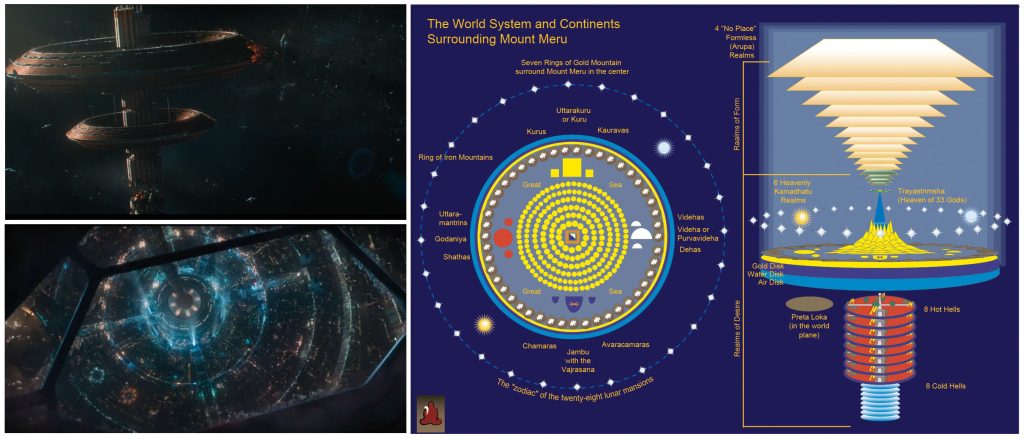
Plato shared the story of Atlantis, a technologically advanced civilisation renowned for its navigation and nautical skills, which allowed it to maintain a vast global network of stations. He indicated that by its catastrophe, the Atlantean society was already declining due to corruption, noting that “Atlantis ceased to wear its prosperity with moderation.” Many believe Atlantis is merely a myth and not a historical reality. However, Plato asserted that it was true, claiming that Atlantis was submerged 9,000 years before the time of Solon. In 600 B.C., Solon travelled to Egypt, where priests informed him of the story of Atlantis inscribed on temple walls. This timeline corresponds to 9,600 B.C. in our calendar, or approximately 11,600 years ago. This narrative is further supported by geological findings at Göbekli Tepe, which is thought to date from around the same period. It is believed that survivors of Atlantis in that region shared their technology with local hunter-gatherer communities.
We discussed the notion of timelessness as a quality that provokes dreams, and sometimes, in its archetypal dominance, it can predict ‘prophecy’ or future events. This archetypal dominant keyframe in history is always centred on the sacred centre. In the San script, it’s described as ‘Meru’ to mean the ‘Holly Mountain’, and Meru is described as the mountain of the gods. Which parallel Greek and Roman mythology concerning Mount Olympus and pantheon gods. The pantheon gods then intermingled with the Kabbalistic myth of Stars, which evolved into the Copernicus satellized universe. However, when it comes to prophecy, that label belongs to ‘Noah,’ where, according to some researchers, he walked and talked with God and was [speculatively] an Atlantean being. His dream-prophecy was, of course, the flood.
Another prophet who is rarely mentioned is Nebuchadnezzar, particularly in the context of Simon Magus. In Acts 8:9, Simon Magus is described as a sorcerer. I suspect that fundamentalists, especially traditional fundamentalists (which I use to describe those who are predecessors of the New Fundamentalist Christians), refer to this verse as a go-to reference. This is likely because they tend to deny intuition. This is strange, considering intuition is inherent and instinctual for everyone, even among the most rational or rigid Christians.
Fundamentalist Christians focus on a transfixed reference as an authority as evidence and means of comparison. Simon Magus’s tree of life is an analogy to that of the nature of God; in this appointed heresy, it’s used as a reference point to promote other institutional beliefs that do not match their own, as modern-day witch-hunters. Simon Magus merely saw an association or synchronicity between the Tree of Life and its association with the nature of God. This was foolish of Magus as he made himself out to be a target of heresy, so much so that it made its way into Religious text. Hippolytus describes Magus paraphrasing the Law of Moses:
Could it be that Magus is describing what it might’ve been like (or imagine; imagination has a hand in the developmental aspect of intuition) to witness the Tree of Life that reached to the Heavens (in this case, the Sky) being burnt down with the super-celestial fire. Interestingly, this is no ordinary fire but something heavenly; this would make sense if one were to consider the notion of a giant tree in the centre of the earth, once located at the North Pole. This story was made more pronounced through a prophetic dream by Nebuchadnezzar –Nebuchadnezzar dreams of a great tree that shelters the whole world. Still, in his dream, an angelic “watcher” appears and decrees that the tree must be cut down and that for seven years, he, Nebuchadnezzar, will have his human mind taken away and eat grass like an ox.
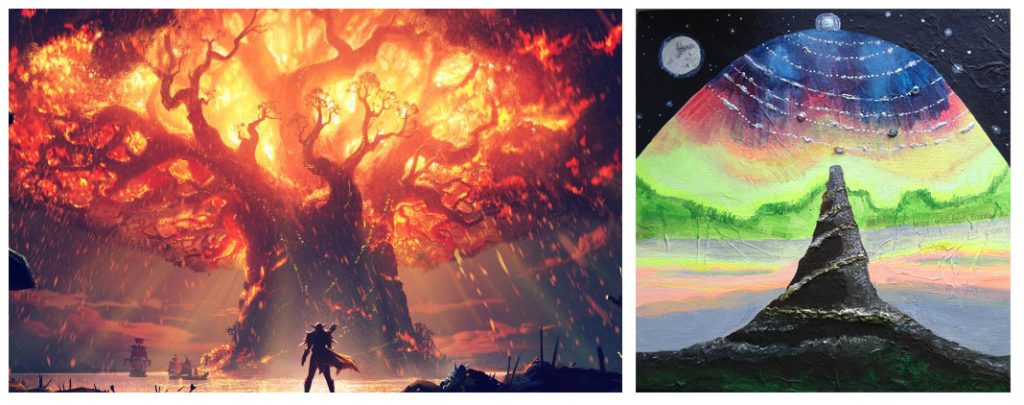
Fire is the Original Principle: Simon Magus describes fire as the originating principle of the universe, and he uses the content from ‘Heraclitus The Obscure’ to apply his notion that God is not the fire but a burning consuming fire, taking Moses’s assertion of “God is a burning consuming fire” out its correct context (law of Moses), according to scholars. Instead, he describes the fire as an Indefinite Power that will be kept hidden (secret) and repose in the habitation, at the foundation of which lies the root of all things. [And he asserts that this man who is born of blood is (the aforesaid) habitation, and that in him resides an indefinite power, which he affirms to be the root of the universe – Hippolytus]
He describes this indefinite power (fire) as one of the four elements, but within the fire, it represents two folds of nature: secret and manifest. The hidden aspect is assumed by scholars as something akin to Aristotle’s “potentiality” and “energy” or Plato’s “intelligible” and “sensible”, considering the manifest portion of the fire is derived from the secret. Maybe it’s more akin to Prometheus’s fire, the powers to imagine and to intuitively create fire, therefore finding its secret as manifest, its potentiality and its energy. In the East, the Statuary of Laotian Buddha figures are shown with flames (fire) atop their heads, symbolising enlightenment.
The creation of the world and the unbegotten fire heralded new growth. The fire is said to have taken six roots, which serves as an allegory for the primary originating principle that has influenced generations. He describes these roots as pairs, naming them “Mind” and “Intelligence.” This concept aligns with the Tree of Life. In the framework of the Ten Sefirot, “Crown” represents Wisdom, while “Intelligence” corresponds to the second and third Sefirot. These are parallel emanations from the Crown or the first Sefirah. The first three Sefirot together form a triad representing the world as a manifestation of the Divine Thought.
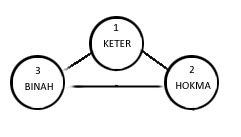
[As a disclaimer, I’m not a theology scholar, and I will admit I’m out of my depth here; I’m just piecing together current views that pop up in front of me.] Magus describes (assumes, could he be one of the first few conspiracy theorists or gnostic) the fruit (which has seeds) of the tree being saved and deposited in a granary and laid in a storehouse, and the rest as in the stem can be burnt because the trash is not generated for its own sake but for that of the fruit. Then that would mean the fruit would be divine when fully grown and has received its form being kept in a storehouse (granary).
Fire is part of nature and is part of the ecosystem. Native aborigines would purposely burn bushland with fire because they knew that no new growth could flourish without the periodic reduction of combustibles through fire. This notion mirrors the death and rebirth concept symbolised in an allegorical story for the Tree of Life. Its seed represents the gestation into the flower of life, which promotes spiritual awareness of sacred geometry symbols and the plutonic solids that come out of it.
There is also the notion of god’s fire within the backdrop of a Mountain, that of Moses conversing with a spiritual fire. Part of the constellation of images that come up in determining a Holy Mountain would be to collect all images and stories concerning the myth. Some considerations to consider are the size of the mountain and its permanency and immovability; we move towards or ascend the mountain metaphorically to reach enlightenment and physically travel there to witness or be within the heights of the heavens. Beyond its size, there is the mountain as a symbol and its involvement in creating and recreating worlds. Many world mythologies start with prima-materia, which means that the world’s first creation was in the form of a mountain; this mirrors sensibilities towards Mother Earth’s creation and the goddess. Another term associated with the centre of the world is the naval.
Incidentally, Magus describes Paradise as a Womb and Edem as the afterbirth, “a river flowing forth from Edem, to irrigate Paradise” the Naval. God formed man in his mother’s womb – in Paradise. He states the navel is separated into four principles represented as two arteries (the channels of spirit) and two veins (the channels of blood). Magus is making allegorical similarities between the nature of gestation and birth and the physical creation of the world. When one flies on an aeroplane, we see from great height rivers that seem like veins. He describes the river that proceeds out of Edem (I suspect Edem is Eden) as divided into four principles or four channels of senses: seeing, smelling, taste, and touch, much like a child with its four senses.
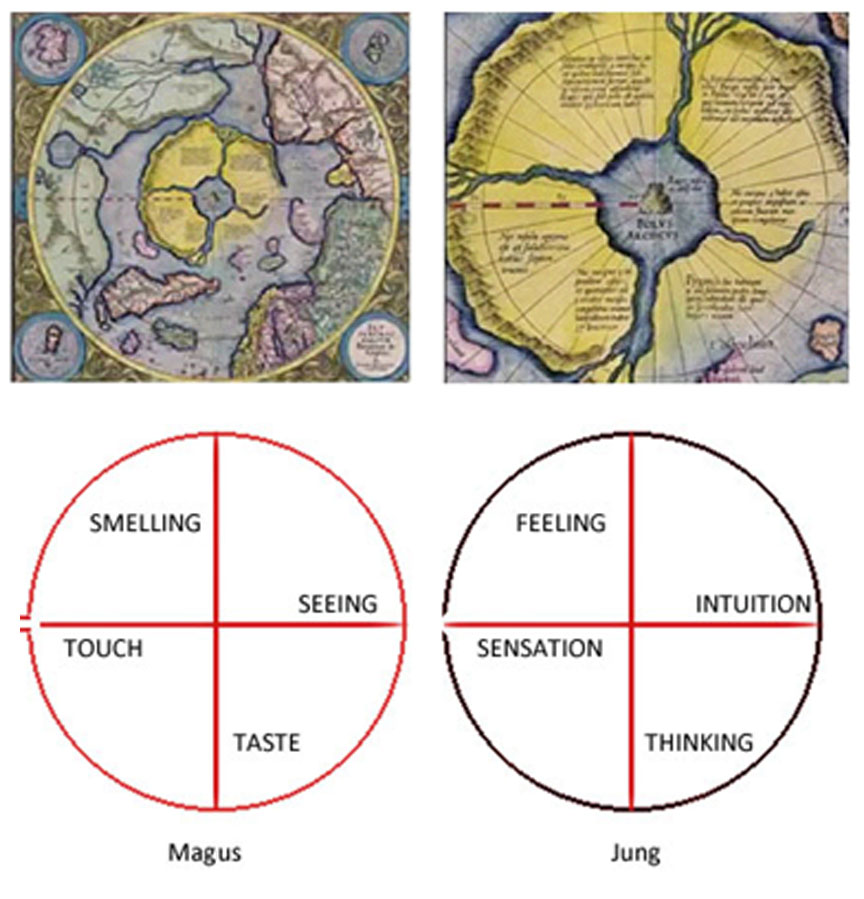
| There is a specific link between Magus’s notion and Jung’s theory of types. The dominant function is opposite to the inferior function. If your thinking function is the best developed, your feeling function will be the least developed. The inferior function is also the gateway to the unconscious. |
.
It took Jung and his Schema of types to finish Magus’s notion, which he says is the ‘Law … that Moses appointed.’ When a child is born, they’re essentially in an oceanic state; as the child grows into adulthood, often some become brainwashed (or demoralized), pragmatic, rigid, inflexible, and so on. This is a forgetting – but with some comes the fire (much in the way of the spark of divinity; some describe it as an awakening). People have become more in tune with Jung’s schema of types as a method.
Jung observed that people could be divided into four groups according to their dominant psychological functions. The thinking and intellectuality parts belong to the thinking types; those who are oriented toward emotions are feeling; the body’s sensations represent sensation. These types are not original creations of Jung – they can be traced back to the Republic of Plato; however, he did introduce Intuition to the fold. The kind of Intuition where perception cannot be traced directly to conscious sensory experience – therefore [R. Smoley & J. Kinney of Wisdom Teachings] defines sensation as “perception through conscious sensory processes, and intuition as perception by way of unconscious contents and connections.”
.
.

